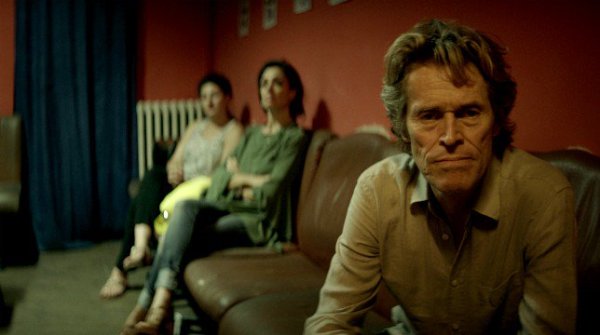Film Review: “Tommaso” — A Portrait of the Messy Inner Life of an Artist
By Tim Jackson
Director/writer Abel Ferrrara, who often features character actors such as Christopher Walken and Harvey Keitel in his movies, has found a kindred spirit in Willem Dafoe.

Willem DaFoe in Tommaso.
Tommaso, the new film written and directed by Abel Ferrara (which begins streaming tomorrow) is an imaginative work of creative psychotherapy that swings from delight to frenzy. In this loose combination of autobiographical material drawn from Willem DaFoe and Ferrara, Dafoe plays a screenwriter living in Rome. Ferrara has cast his own wife, Cristina Chiriac, and their 3-year-old daughter as the family. Domestic scenes were shot in the director’s apartment by way of a hand-held camera. The result is that we feel we are taking in a spontaneous documentary, albeit punctuated by energetic flights of fancy. For Ferrara, interweaving present fantasies and his past are integral to how he makes art. So it is should not be surprising that this expressionistic profile is short on plot — it is a portrait of the messy internal life of an artist. It is a carefully structured landscape of the mind — a personal statement filtered through the dreams of two friends.
Ferrrara, who often features character actors such as Christopher Walken and Harvey Keitel in his movies, has found a kindred spirit in Dafoe. The two friends (and neighbors in Rome) have now completed a number of projects together: most recently Pasolini (2014) and Siberia (2020). Dafoe’s breezy Midwest charm offers a welcome counterbalance to Ferrara’s volatile reputation as an iconoclastic New York filmmaker in films such as The Bad Lieutenant, King of New York, and Driller Killer. After 9/11, discouraged with the city and with censorship, the director moved to Italy where financing was more accessible. Dafoe cut his acting chops with the experimental New York Wooster Group. His long list of credits includes a history of playing extreme characters, such as Jesus in Scorsese’s The Last Temptation of Christ, “Him” in Lars von Trier’s Antichrist, and the God-like Thomas Wake in Robert Eggers’ The Lighthouse.
Tommaso comes off as a comfortable collaboration between Ferrara and Dafoe. The actor’s relaxed allure redeems Tommaso’s occasional temper tantrums. References to Dafoe’s past films are included with ease. The AA meetings, where Dafoe delivers some nakedly confessional monologues, reflect Ferrara’s alcoholic past. In his acting workshops, Dafoe’s Tommaso inspires young performers, running them through exercises and offering cogent acting advice that also provides a key to Ferrara’s intentions as a filmmaker:
“These are all simple games, the double focus that you have. For me performing is always between control and abandon. So when we do these things that don’t seem to go together- seem to makes you feel off balance. But if you can relax in that state it makes you feel more emotionally available. When you get close to doing things in a spontaneous way that, for me, is the beauty of life.”
The idea is conventional enough: art is about creating order out of chaos. What changes is that, as artists age, they learn to simplify their methods, to take shortcuts that lead to what’s important and vital. How are fitful daydreams smelted down and transformed into art? Tommaso takes us into the interior life of the artist as the protagonist sits down to scribble his ideas into a screenplay; we snake through fantasy, confession, and confrontation. Ferrara’s life story becomes part of the torrid landscape of consciousness, with all of real life’s temptations and insecurities interrupting the process of creation. Complacent contemplation is not what one expects from this director and Ferrara’s signature pulpy tone emerges as Tommaso grows increasingly frustrated with his life, suspicious of his marriage and, like so many of his protagonists, ready to go off the rails.
Despite the fantasy sequences (we have to decipher the actual from the imagined), Tommaso sits firmly in the everyday. The character takes walks with his daughter, shops at the local market, cooks dinner, socializes at cafes, works with an Italian tutor. He practices yoga and meditates (at which Dafoe appears to be accomplished). Documentary clips are used to provide commentary. But there is a creeping unease. He’s distrustful of his May /December marriage and frustrated as an artist. Intimate scenes with Chiriac have an unsettling and voyeuristic quality, as do the more volatile scenes in which the director’s child appears to be visibly upset. These tone shifts are self-conscious expressions of the director’s relish for tumult.
I’m not giving anything away to say that a cinematic reference provides one of the film’s more humorous juxtapositions. The end credits are accompanied by the song “Tu vuo fa l’americano,” as sung by Sophia Loren to Clark Gable in It Happened in Naples (1960). It’s a comical and refreshingly cathartic conclusion to Ferrara’s wild emotional ride.
You’d like to be an American
‘merican, ‘merican
but listen to me, is it worth?
you want to be trendy
but if you drink “whiskey and soda”
you have a long hangover
Tim Jackson was an assistant professor of Digital Film and Video for 20 years. His music career in Boston began in the 1970s and includes some 20 groups, recordings, national and international tours, and contributions to film soundtracks. He studied theater and English as an undergraduate, and has also has worked helter skelter as an actor and member of SAG and AFTRA since the 1980s. He has directed three feature documentaries: Chaos and Order: Making American Theater about the American Repertory Theater; Radical Jesters, which profiles the practices of 11 interventionist artists and agit-prop performance groups; When Things Go Wrong: The Robin Lane Story, and the short film The American Gurner. He is a member of the Boston Society of Film Critics. You can read more of his work on his blog.

